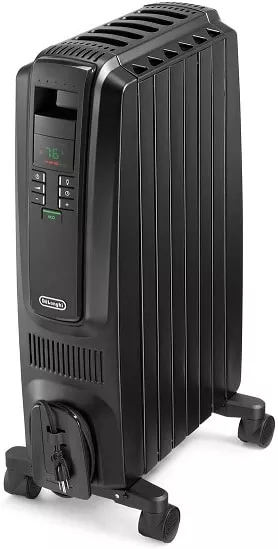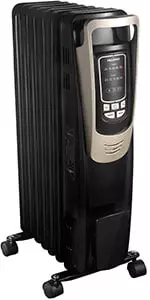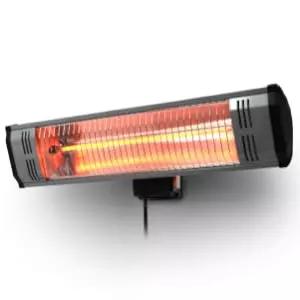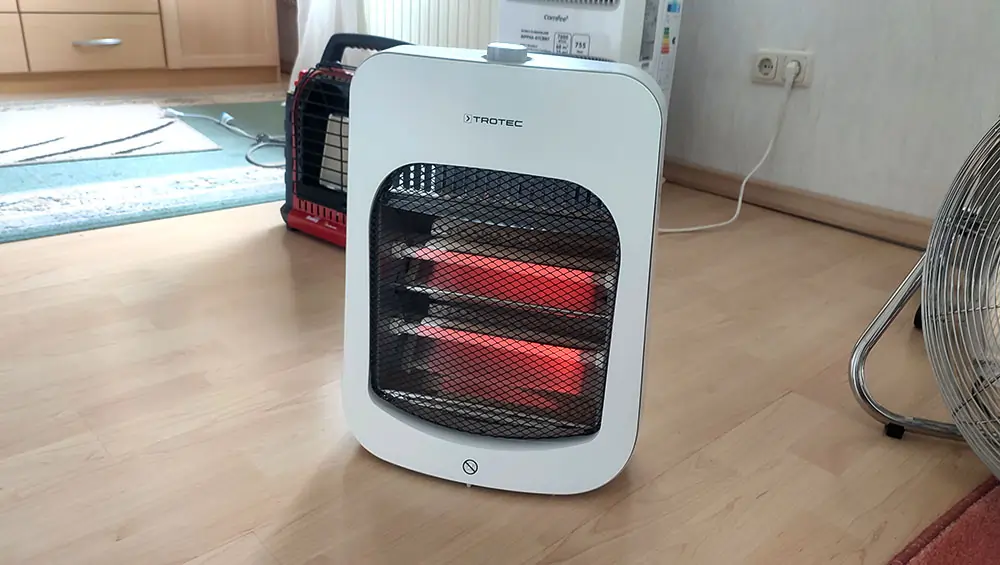Fanless heaters have several advantages when compared to regular electric space heaters:
- No wear-down: Since they have no built-in fan, they don’t wear down over time
- No maintenance: Since they contain no moving parts, they are maintenance-free.
- No cleaning: Since there’s no constant stream of air passing through the heater, it does not accumulate dust, and, therefore, does not need cleaning or built-in air filters.
- Silence: Fanless heaters are 100% silent.
Based on these findings, we can already tell that maintenance-wise and technology-wise, fanless heaters are superior to most other electric space heaters.
Technically, they are flawless.
Or are they?
In this article, we’re having a look at 4 of the best fanless electric space heaters. And we’re also going to have a look at the downsides of space heaters without fans.
Not having a fan is usually, but not always, an advantage. So, let’s start with a note first:
Not having a built-in fan is NOT a Safety Advantage
If you want a fanless heater for safety concerns, then you’re looking for the wrong thing.
The fans in most space heaters are completely inaccessible from the outside unless you deliberately poke a stick through the safety grid down into the heater.
But the chance of chopping your finger off is close to zero. Fans in space heaters are not safety concerns.
By coincidence, however, the very safest space heaters, oil-filled radiators, do not have built-in fans. I don’t consider them the safest space heaters because they are fanless, but because they have no exposed heating element.
So, if you want the safest possible space heater, you maybe should have a look at this guide on the safest space heaters.
And if you’re looking for child and pet-safe space heaters, look at this guide on the best child-safe space heaters.
I emphasize this because infrared heaters, especially fanless ones, rely on exposed (easily accessible) heating elements to radiate the heat. Consequently, especially fanless heaters are to be taken with a grain of salt if your sole goal is to pick a safe heater.
Fanless heaters can be either very safe (such as oil radiators), or very unsafe (such as infrared heaters with exposed heating elements). There is no correlation between heater safety and the presence of a built-in fan.
When to pick a fanless heater?
Okay, then why should you even care about getting a fanless heater, if it’s not for safety?
The answer is: You should pick a fanless heater if you care about 100% silent and maintenance-free heating.
And for many people, that’s already enough of a reason to get one.
So, let’s have a look at my recommended fanless heaters:
4 Best Fanless Heaters
1. DeLonghi Dragon oil-filled radiator
The best fanless heater is the DeLonghi Dragon oil-filled radiator (click here to see it on amazon).
It has all the advantages of a fanless heater: It is 100% silent and never requires cleaning or maintenance.
And on top of that, it is the safest form of fanless heater: an oil-filled radiator.

Oil radiators are very safe because they do not expose the built-in heating element. The heat source is completely inaccessible from the outside and embedded inside the sealed metal heating body, where it’s drowned in oil.
The hot oil then carries all the heat to the finned surface which converts it to hot air, which self-distributes, completely without a fan.
Even though oil-filled radiators output the same heat as other space heaters (1,500 Watts), they are safe to touch and can’t start fires.
One thing I like a lot about the DeLonghi Dragon, and that’s why I ranked it as the best fanless heater, is its smooth and edgeless design. Regular oil-filled radiators have a finned design (the classic radiator look) with sharp edges. The DeLonghi Dragon uses an original thermal slot design which is child and pet-safe.
And that’s what makes it better than most other oil-filled radiators.
2. Pelonis Oil-filled Radiator
The second-best fanless space heater is this Pelonis oil-filled radiator (click to view it on amazon).
Pelonis is my personal favorite radiator brand, because they are really affordable, especially when compared with brand products such as DeLonghi heaters.
This Pelonis oil heater costs just half as much as the DeLonghi Dragon. And, I’d say, for most people, the Pelonis is going to be the better choice cost-wise.

Here’s why:
Pelonis oil-filled radiators lack (almost) nothing. They are just as silent as DeLonghi radiators. They output the same heat. And they come with all the same technical safety features such as tip-over protection, overheat protection, a built-in timer, and a thermostat.
BUT the Pelonis oil-filled radiator still has the classic oil-filled radiator design, with its sharp fins. Technically, this design is ideal for heat distribution. But it’s not great when you have kids.
I wouldn’t want my child banging his head against it a metal fin.
And that’s why I put the DeLonghi Dragon on rank #1. But overall, if you don’t have children who will bang their heads against the heater, I highly recommend the Pelonis heater.
At just a fraction of the cost, you get the exact same heating experience as with any more expensive branded heater.
3. Heat Storm Tradesman Infrared Heater
Okay, that’s enough oil-filled radiator recommendations. In the introduction, we also discovered that infrared heaters can be fanless. However, there’s a drawback.
Infrared heaters produce very hot temperatures. And because they rely on direct heat radiation, the infrared heating tubes have to be exposed.
So, by technical necessity, fanless infrared heaters need to have an open design. Otherwise, the infrared heat can’t escape and infrared heaters would overheat.
That’s not the case for infrared heaters with fans. With a built-in fan, infrared heaters can blow the heat away from the infrared heating tubes and cool themselves.
Anyway, here’s my recommendation for a strong 1,500-watt fanless infrared heater: The Heat Storm HS-1500-OTR infrared heater(click to view it on amazon).

As the name suggests, it is a “pure” infrared heater. It has an industrial look to it, because, as explained earlier, the infrared tubes must be as exposed as possible to make the heater work without a fan.
I have linked the option which comes with a ceiling mount, because I like to keep my floor space free. But you can also choose the tripod variant if you want to freely place the heater wherever you like it.
4. Small Fanless Infrared Heater
My last recommendation is this small infrared heater (click to view it on amazon). It’s a fanless, free-standing space heater.
Because it’s fanless and free-standing, it is, however, limited to 500 Watts oif heat output.
So, compared to the other heaters on this list, this one is significantly weaker.
But if having no fan is a requirement for you, that’s the way it is. Without a fan to dissipate heat, many infrared heaters have to size down. Otherwise, they’d overheat.
I have a similar 800 Watt infrared space heater at home. And it is strong enough to keep a small room such as a small office warm.
And even though it’s comparably weak, the infrared tubes still get very hot (>900°F). So, the closer you place it to yourself, the warmer you’ll feel.
What’s the better fanless heater: Oil-filled or Infrared Heater?
Let’s keep the answer to this simple. If you’re looking for a safe, fanless heater, oil-filled radiators are always the better option.
They do not expose heating elements, they output a full 1,500 Watts of heat, and they are reliable.
Fanless infrared heaters are usually either very small models (~500 Watts), because without a fan that blows the heat away, it’s safer to output less heat, or they are large 1,500 Watt heaters, but with very exposed heating elements and an industrial look and feel to them.
For living spaces, oil-filled radiators are always the better fanless choice. Fanless infrared heaters are only good in garages and workshops.
